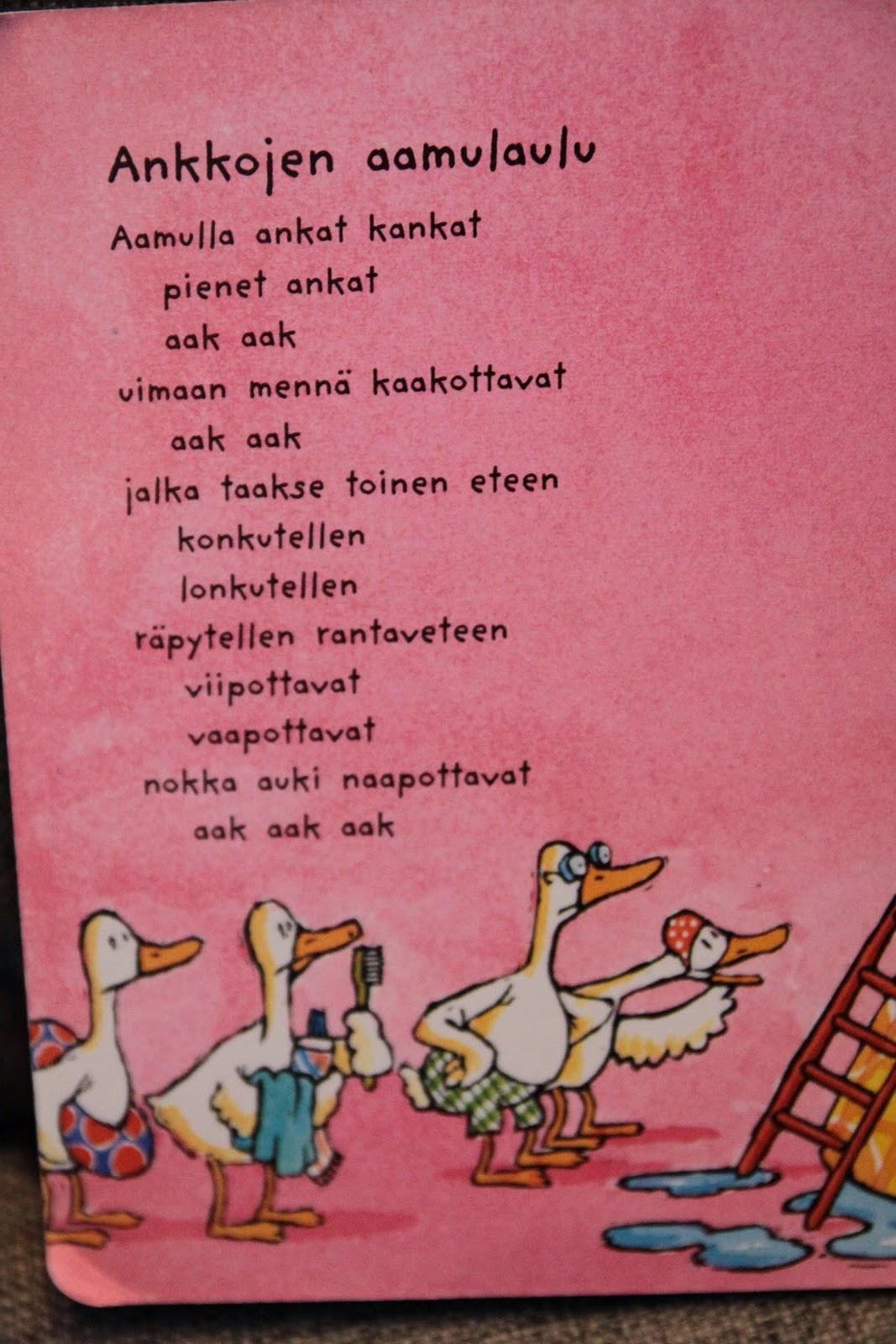Tiitiäisen satupuu (1956)
Tiitiäisen pippurimylly (1991)
Tiitiäisen tuluskukkaro (2000)
Tiitiäisen runolelu (2002)
Tiitiäisen satupuu ( 1959, The fairytaletree of Tiitiäinen)
Illustrated by Maija Karma.
Finland’s most beloved nonsense poem collection from 1956. The collection has 43 poems. This is a timeless classic that fascinates kids today as well as their parents and grandparents. The most famous characters are Haitula, Tiitiäinen itself, Emotional hedgehog, Mr. Pii Poo and Ville and Valle.
With this collection Ms. Kirsi Kunnas modernized Finnish childrens Lyric poems. She used the English Mother Goose as her inspiration. Before Tiitiäinen, the children’s poems had predictable rhymes and very educational attitude.
Ms. Kunnas wanted to cut loose from all that. Her poems are full of linguistic play, humor and satire that address both adults and children.
 |
| Metsähiisi |
(Loosely translated from Tiitiäinen, metsäläinen by Kirsi Kunnas)
Tiitiäinen, metsäläinen
Tiitiäinen metsäläinen, pieni menninkäinen.
Posket on tehty puolukasta, tukka naavan tuppurasta,
Silmät on siniset tähdet, silmät on siniset tähdet.
Tiitiäinen metsäläinen, pieni menninkäinen.
Keinu kuusen kainalossa, tuutu tuulen kartanossa,
Sammuta siniset tähdet, sammuta siniset tähdet.
 Tiitiäisen pippurimylly (1991, Peppermill of Tiitiäinen)
Tiitiäisen pippurimylly (1991, Peppermill of Tiitiäinen) Illustrated by Julia Vuori
Undertitle: Not to too small or too big, but to all who have a peppermill.
The poems in this book are shorter than in the first book. Only Ville and Valle and the Waterrat appear in this book. The title sets the tone: the language is grinded in short poems rather than in fairytales. The poems deal with life phenomena or a word that is first wondered and then laughed at. The whole story strats to unravel and becomes nonsense. These poems have more rhymes that the first book, but just as the reader gets a hold of the rhyme, it is broken again.
Eli Lievestuoreessa tuore lipeäkala,
läpikotaisin kipeä kala.;
Kun sataa noita-akkoja ja hirveitä hirvenkakkoja - -;
Kun kuu on puoliksi valkea ja puoliksi musta,
on kumma ettei se halkea ja herätä kummastusta.
This collection has 85 poems that are categorized under eight titles. Each category has its own themes, there are hilarious characters, odd things, car poems, cat and mouse poemsl, weather and animal poems.
Tiitiäisen Tuluskukkaro (2000 Flint bar purse of Tiitiäinen)
 Illustrated by Kristiina Louhi
Illustrated by Kristiina LouhiAlphabetical poems. That happens to guinea pig and walrus in Mercedes (Finnish marsu, mursu and Mersu)? The circus is also in town and an onomatopoetic worm. (mato is worm in Finnish). The word play captures the attention of even the young readers. Wordplay at its best.
 |
| Guinea pig and walrus in Mercedes |
 Tiitiäisen Runolelu (2002, Poem toy of Titiäinen)
Tiitiäisen Runolelu (2002, Poem toy of Titiäinen) Illustrated by Christel Rönns
This book has 15 poems from other Kirsi Kunnas poem collections. The poems are turned in to finger plays to create a connection between touch, voice and words. The book includes even a Finnish version of Hickory Dickory Dock.
 |
| Ducks' morning song |
Sormiloru (Fingerpoem),
Tänään (Today),
Hikkori tikkori toikki (Hickory Dickory Dock),
Jänöjussi Puputti ( Bunny Puputti),
Hoppeli Hopp,
Ankkojen aamulaulu (Ducks’ morning song),
Metsäsianpossuntossu (Forest pig’s piglet slipper),
Tiitiäisen tuutulaulu (Lullaby of Tiitiäinen),
Nuku nuku (Slepp, sleep),
Aa aa lapsoseni,
Niityllä pipipilipom (At the medow),
Kissat ja hiiret (Cats and mice),
Wow Wow,
Iloinen auto (Happy Car),
Kysymyksiä ja vastauksia (Questions and answers)


No comments:
Post a Comment